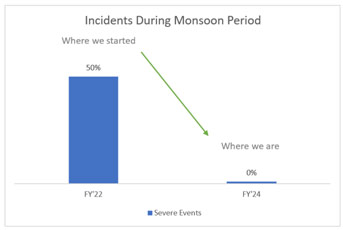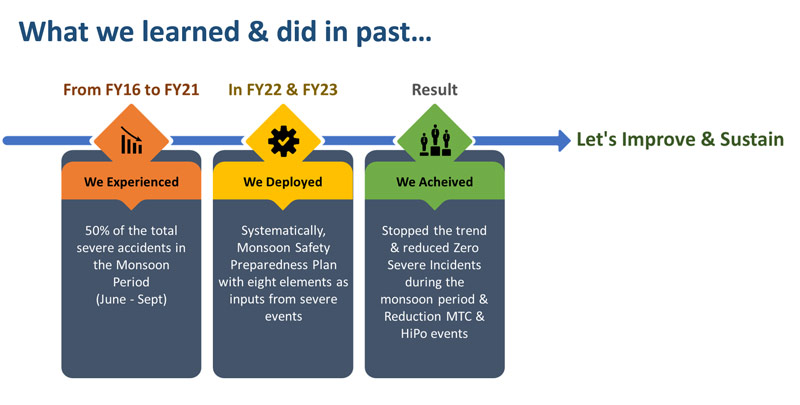Tata Projects’ strategic deployment of its monsoon safety programme has produced remarkable outcomes over the past three years. This resulted in a new milestone during the FY2024 monsoon season as the company successfully reversed the trend of experiencing severe events, bringing it down from 50% to 0%.
This success is based on the adoption of the DMAIC model, as explained below:
Define
The monsoons have a significant impact on construction activities across India. Studies, such as those presented at the Industrial Engineering and Engineering Management Conference, indicate that monsoon unpreparedness can lead to a 5% increase in project duration and a 12% rise in costs.
Measure
During an in-depth analysis of severe accidents, data from Tata Projects (FY2016-FY2021) revealed that 50% of its accidents occurred during the monsoon season (June 15 to September 30, typically). This emphasised the need for proactive safety measures during this season.
Analyse
The absence of site-specific planning, preparedness, and monitoring had amplified the company’s monsoon challenges. Additionally, elevated accident rates stemmed from a lack of awareness and training among the workforce regarding monsoon-related risks.
Improve
Hence, Tata Projects introduced the monsoon safety programme as part of its risk reduction programme (RRP). This was designed to ensure that proactive measures are always in place to mitigate any monsoon-related risks. Accordingly, the company prepared a structured deployment plan with defined timelines as below:


- Launch of monsoon safety programme: Commencing the monsoon safety programme with structured guidelines and previous statistics to kick-start its preparedness
- Capacity building: Conducting awareness sessions for all health, safety and environment (HSE) resources, RCM (Project Operation Leads), and Project Planning Leads to enhance understanding and readiness
- Preparation of project-specific plan: Preparing project-specific plans to address local monsoon risks, facilitated by brainstorming sessions within project teams
- On-ground implementation: Putting the prepared plans into action on-site to ensure effective risk mitigation
- Joint self-assessment through TQDigi’lytics: Utilising the company’s TQDigi’lytics digital platform, each project must conduct monthly self-assessments during the monsoon period with a joint RCM and project team. This includes a comprehensive checklist covering eight assessment criteria/critical focus areas, which are derived from the causes of previous incidents, each having varying weightage
- Audits for critical projects: Based on self-assessment scores and project criticality, centralised audits must be conducted monthly across all business units to ensure adherence to monsoon safety protocols
- Knowledge sharing: Extracting common findings from audits to disseminate learnings across the organisation, fostering a culture of continuous improvement and safety awareness.

Control
Tata Projects’ strategic deployment of the monsoon safety programme has produced remarkable outcomes in the last three years leading to zero accidents in the FY2024 monsoon season. By laying emphasis on enhancing site-specific preparedness, the company has drastically reduced disruptions, ensuring smoother operations even in challenging weather conditions.



